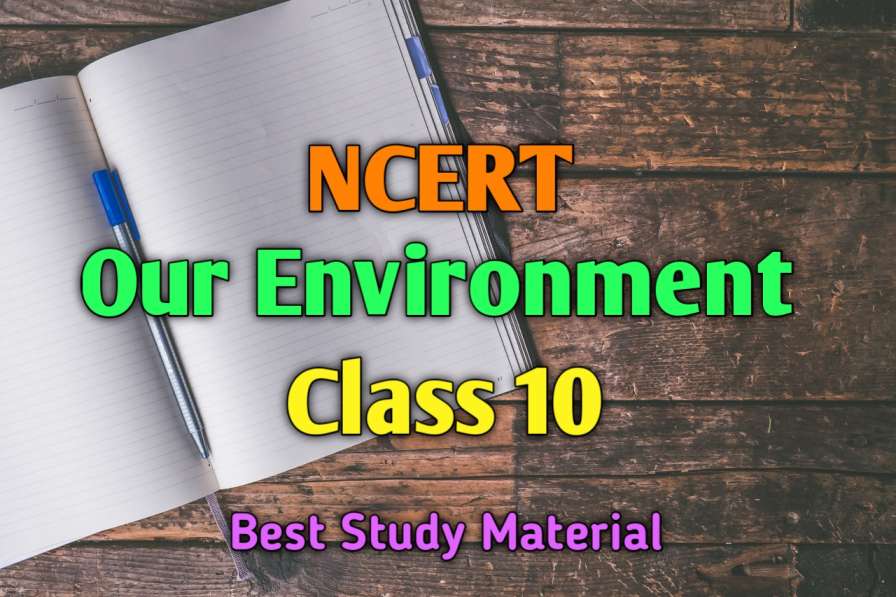In this Chapter, Our Environment we should learn about ecosystems, decomposers, food webs etc in simplified form.
Environment includes our physical surroundings such as air, soil, water, animal and plants. Which adapt themselves to their surroundings.
All waste material produced by various activities of man and animals is poisonous to some extent and can be divide into two groups Biodegradable Waste and Non Biodegradable Waste.
Biodegradable Waste: Those Waste material that can be broken down into non poisonous substances in nature by action of micro-organisms are called Biodegradable Waste. For Example Dung, Compost, Wool, Paper, Wood, Grass etc.
Non Biodegradable Waste: The Waste material that cannot be broken down into non poisonous substances in nature are called Non Biodegradable Waste. For Example Plastic, Polythene Bags, DDT, Synthetic Fiber.
Ecosystems
An Ecosystem is a self content unit of living things and non living environments. For Example Grassland, Forest, Desert, Mountain etc.
Component of an Ecosystem
All ecosystem are made up of two main components Abiotic Components and Biotic Components
Abiotic Components: The Abiotic components of an ecosystem include a physical environment like soil, water, air along with inorganic substances like CO2, N, O2, H2O and other elements present in them.
Biotic Components: The Biotic components are made up of three types of organisms Producers, Consumers, Decomposers.
- Producers (Autotrophs): All Green Plants
- Consumers (Heterotrophs): All the Animals
- Decomposers (Saprotrophs): Some bacteria and fungi
Producers trap solar energy and then provide basic food for energy for all other life forms in the ecosystem.
The Microscopic aquatic plants freely floating on the surface of water are called Phytoplankton.
The Aquatic Microscopic Animals that freely float on water are called Zooplanktons.
Decomposers
The microorganism that break down the complex organic compounds present in dead organisms like dead plants, animals and their products such as urine, fesses into simpler substances are called Decomposers. For Example Bacteria, Fungi.
Importance of Decomposer
Decomposer help in decomposing the dead bodies of plants and animals and act as cleaning agent of environment.
Food Chain
The sequence of living organisms in community in which one organisms consumes another organisms to transfer food energy is called food chain. For Example Grass to Deer to Lion, Grass to Grasshopper to Frog to Snake etc.
Food Web
The interconnected food chain operate in an ecosystem that establishes a network of relationships between different species is called the Food Web.
Trophic Level
The Position in the food chain at which the transfer of energy takes place is called trophic level. The trophic level in food chain can also be represented by a Pyramid of numbers.
Ten Percent Law (10% Law)
According to this law only 10% of energy entering a particular trophic level of an organisms. So Higher Trophic Level organisms get more energy in compared to Lower Trophic Level organism.
For Example Sun (1000 Joules) to Plant (100 Joules) to Deer (10 Joules) to Lion (1 Joules).
Biomagnification
The increase in concentration of harmful chemical substances like pesticides in the body of living organisms at each trophic level of the food chain is called Biomagnification.
Ozone Layer
Ozone molecules are made up of 4 atom of oxygen that combine together. It is poisonous in nature. On the UV radiation impact O2 molecules are divided into Single Oxygen atoms. Then that single atom of oxygen combine with molecules of oxygen O2 to form Ozone (O3).
Ozone layer is very important for the existence of life on earth because it absorbs most of the harmful UV radiation coming from the sun and prevents it from reaching the earth. Depletion of Ozone layer is due to the impact of Chloro Floro Carbon (CFCs).
Managing the Garbage
Managing the Garbage refer to the proper disposal of waste in such manner that it will not pollute the environment. It consists of Recycling, Preparation of compost, Incineration, Landfill, Sewage Treatment.
- Recycling: Renewing the garbage or disposed waste after using comes under recycling for example Metal, Paper etc.
- Preparation of compost: Biodegradable domestic waste such as food, fruits, leaves can be converted into compost by burying in a pit into ground and used as the manure.
- Incineration: Incineration refer to burning of substance at High Temperature (More Than 1000 C) to form into ashes.
- Land Fill: The disposal of waste by putting it in the low lying area of ground and covered it with earth.
- Sewage Treatment: The dirty drain water contain urine and other harmful substance that is discharge from the home by underground pipelines is called Sewage. It is disposed by treating it on Sewage Treatment Plant. This Sewage Treatment Plant produce clean water which is discharge into the river.
Also Read







1 thought on “Our Environment Class 10 Science Notes Chapter 15 CBSE”